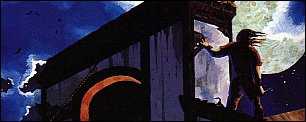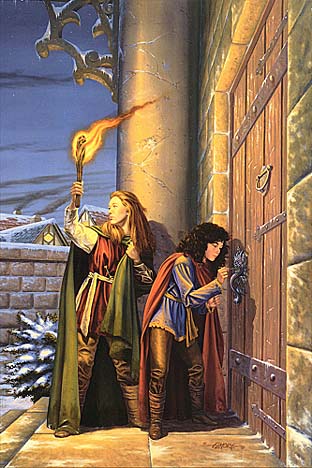Thief Abilities-

Thief Abilities-

| - | - | - | - | - |
| Character Classes | - | - | - | DMG |
The following additional
explanations of thief abilities will help you to prevent abuse of these
activities by thieves,
and other characters able
to use these abilities in whole or in part, in your campaign.
Roll of the dice for any
thief function must be kept absolutely secret,
so the thief (or similar
character) does not know the results!
Back
Stabbing: Opponents aware of the thief will be able to negate the attack
form.
Certain creatures (otyughs,
slimes, molds, etc.) either negate surprise or have no definable "back",
thus negating this ability.
Failure allows additional
attempts.
The victim might notice
and allow
the thief to opercte anyway in order to track him || her back to the place
he or she uses as a HQ.
Up to two attempts at picking
a pocket can be made during a round.

The act of picking the lock
to be opened can take from 1-10 rounds, depending on the complexity of
the lock.
As a rule, most locks will
take but 1-4 rounds of time to pick.
<30 points of damage will
break open a padlock: T1-4.72>
<another example, 25
points will break a padlock: T1-4.81>
<another example, 30
points of damage will break open a lock: T1-4.49>
<another example, 35
points of damage will break open a lock: T1-4.52>
<condense the above>
Finding
And Removing Traps: Use the time requirements
for opening locks. <(From 1-10 rounds, though most traps will take 1-4
rounds to find and remove.)>
Time counts for each function.
Small or large traps can
be found, but not magical or magically hidden traps.
Moving
Silently: Silent movement is the same as normal exploratory movement,
i.e.
12' per round as the thief creeps up (croodles) upon the AREA or victim
or whatever.
Do NOT inform the thief
that his or her dice score indicated a lack of success at this attempted
stealth,
if that
is the case.
He or she thinks the movement
is silent,
and the
monster or other victim will inform the character of his or her misapprehension
soon enough.

Quote:
How did you handle situations where a character of one
class (say Fighter) was attempting to use Move Silently or Climb Walls
- Two situations that when taken literally (i.e. - the Thief can Move with
ABSOLUTE SILENCE whereas someone else might attempt to move stealthily,
and the Thief can climb SHEER SURFACES wheras someone else might climb
a rough cliff, or a tree), would mean that only the Thief could attempt
them, but when looked at in a broader fashion, might be allowed for a character
of any class ?

Generally common sense was applied.
A fighter in metal armor
can't move silently, but without that impediment a Dex ability roll with
modifiers for surface and/or footwear, would be called for.
Hide
In Shadows: As is plainly stated
in the PH,
this is NEVER possible under direct (or even indirect) observation.
If
the thief insists on trying,
allow the attempt and throw dice,
but don't bother to read them,
as the fool is as obvious as a cool pile in a ballroom.
Likewise,
if a hidden thief attempts movement while under observation,
the proverbial jig is up for him or her.
Naturally,
a creature closely pressed in melee is not likely to bother with looking
for some thief not directly in the line of sight,
but if vision would normally extend to the thief's area of activity,
then observation rules apply.
Unobserved
attempts to hide in shadows must likewise stand the hazard of the dice
roll.
A
score greater than the required number shows that the character's ability
is not on a par with his or her intent,
and although he or she THINKS hiding has been successful,
the creature looking in that direction will note a suspicious outline,
form, or whatever.
Note
also that a thief hiding in shadows is still subject to detection just
as if he or she was invisible
(see
INVISIBILITY, DETECTION OF INVISIBILITY
table).
Hearing
Noise:
This is pretty straightforward.
The thief, just as any other
character,
must take off helmet or
other obstructing headgear in order to press his or her ear to the door
surface in order to hear beyond.
see Listening
at Doors +
see Hearing
Noise +

This is probably the most
abused thief function,
although hiding in shadows
vies for the distinction.
The ability to climb walls
is something which is acquired through training && practice,
just as are most of the
other functions of the thief.
The rate at which vertical
or horizontal movement is possible depends upon the texture and other conditions
of the surface.
WALL CLIMBING TABLE, FEET PER ROUND OF CLIMBING
Condition of Surface *
|
|
|
|
|
|
|
|
|
|
|
|
|
|
|
|
|
|
|
|
|
|
|
|
|
* SLIGHTLY SLIPPERY surfaces
DOUBLE
chances of slipping and falling.
SLIPPERY surfaces make chances
of slipping and falling TEN TIMES more likely.
Thus, a slippery surface
cannot be attempted successfully by any thief under 6th level,
and even a 10th level thief
has a 10% chance per round of slipping and falling.
Be sure to check each round
of vertical or horizontal movement for chance of slipping and falling.
Surfaces which are inclined
inwards move towards greater degrees of difficulty --
a non-slippery one being
treated as slightly slippery,
and a slippery one being
virtually unclimbable.
Surfaces inclined away from
the perpendicular on an outward angle may be treated as either a better
surface condition or
a rougher texture, if the
degree of incline is sufficient to make climbing easier.
**
Most dungeon walls will fall into the fairly rough to rough category.
Some will be non-slippery,
but most will be slightly slippery due to dampness and slime growth.
Read
languages:
This ability assumes that
the language is, in fact, one which the thief has encountered sometime
in the past.
Ancient and strange languages
(those you, as DM, have previously designated as such) are always totally
unreadable.
Even if able to read a language,
the thief should be allowed
only to get about that percentage of the meaning of what is written
as his
or her percentage ability to read the tongue in the first place.
The rest they will have
to guess at.
Languages which are relatively
close to those known by the thief will not incur such a penalty.
<note that the original
image in the DMG is based on an image by Gustav Dore>